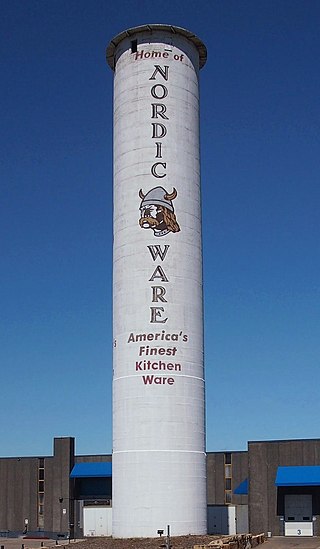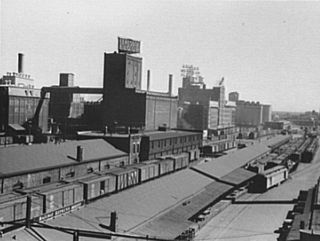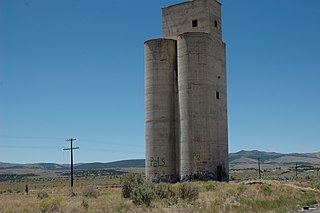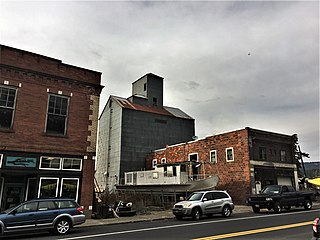
A grain elevator is a facility designed to stockpile or store grain. In the grain trade, the term "grain elevator" also describes a tower containing a bucket elevator or a pneumatic conveyor, which scoops up grain from a lower level and deposits it in a silo or other storage facility.

The National Register of Historic Places in the United States is a register including buildings, sites, structures, districts, and objects. The Register automatically includes all National Historic Landmarks as well as all historic areas administered by the U.S. National Park Service. Since its introduction in 1966, more than 90,000 separate listings have been added to the register.

The Peavey–Haglin Experimental Concrete Grain Elevator is the world's first known cylindrical concrete grain elevator. It was built from 1899 to 1900 in St. Louis Park, Minnesota, United States, as an experiment to prove the design was viable. It was an improvement on wooden elevators that were continually at risk of catching fire or even exploding. Its cylindrical concrete design became the industry standard in the United States, revolutionizing grain storage practices. After its initial experiments, the Peavey–Haglin Elevator was never again used to store grain. Since the late 1960s it has been maintained on the grounds of the Nordic Ware company and is painted with their name and logo.

Northwestern Consolidated Milling Company was an American flour milling company that operated about one-quarter of the mills in Minneapolis, Minnesota, when the city was the flour milling capital of the world. Formed as a business entity, Northwestern produced flour for the half-century between 1891 and 1953, when its A Mill was converted to storage and light manufacturing. At its founding, Northwestern was the city's and the world's second-largest flour milling company after Pillsbury, with what is today General Mills a close third. The company became one of three constituents of a Minneapolis oligopoly that owned almost nine percent of the country's flour and grist production and products by 1905. This occurred as a result of their attempt at a United States monopoly.

Northwestern Consolidated Milling Company Elevator A also known as the Ceresota Elevator and "The Million Bushel Elevator" was a receiving and public grain elevator built by the Northwestern Consolidated Milling Company in 1908 in Minneapolis, Minnesota in the United States. The elevator may have been the largest brick elevator ever constructed and ran on electricity. The elevator was the source for the Crown Roller Mill and Standard Mill. Those mills closed in the 1950s but the elevator continued in use for grain storage until the mid 1980s. The building is a contributing property of the St. Anthony Falls Historic District listed in the National Register of Historic Places in 1971. For this article north is toward the river.

The following are all the contributing resources to the Saint Anthony Falls Historic District in Minneapolis, Minnesota, United States. The District is listed on the National Register of Historic Places, thus these properties are on the NRHP. The "period of significance" of the District was 1858–1941. The district's archaeological record is considered to be one of the most-endangered historic sites in Minnesota.

The Sheridan Flouring Mills, also known as the Mill Inn, are an industrial complex in Sheridan, Wyoming. The mills were a major component of the economy of north central Wyoming, providing collection, storage and milling of locally produced wheat and other grains into flour and other milled products. The original mill was established by Captain Scott W. Snively in the early 1890s. The Sheridan Milling and Manufacturing Company was sold to J.W. Denio in 1903, who operated the mill at its location on Broadway Avenue near downtown Sheridan. A catastrophic fire destroyed this mill in 1919, resulting in the purchase of a new location on Coffeen Avenue and construction of a much larger mill.

Mill City Museum is located in the ruins of the Washburn "A" Mill next to Mill Ruins Park on the banks of the Mississippi River in Minneapolis. The museum, an entity of the Minnesota Historical Society that opened in 2003, focuses on the founding and growth of Minneapolis, especially flour milling and the other industries that used hydropower from Saint Anthony Falls. The mill complex that the museum is within, dates from the 1870s and is listed on the National Register of Historic Places. It is also part of the St. Anthony Falls Historic District and within the Mississippi National River and Recreation Area.
The Tracy Woodframe Grain Elevator was a grain elevator in Muncy, Oklahoma. The elevator was built in 1931 along the Beaver, Mead & Englewood Railroad, the same year Tracy was founded. The elevator operated continuously from its opening until around 1983, outlasting the railroad only a mere 10 years after the last train left eastbound in 1972. On May 13, 1983, the elevator was added to the National Register of Historic Places. The elevator has fallen down. All that remains is a scalehouse that was possibly remnant of a depot for the railroad.

American Grain Complex, also known as "The American", Russell-Miller Milling Co. Elevator, and Peavey Co. Elevator, is a historic grain elevator and flour milling complex located in South Buffalo, Buffalo, Erie County, New York. The complex consists of three contributing buildings and two contributing structures. They are the Elevator Building, Flour Building (1906-1924), office building, Moveable Marine Tower, and railroad tracks. The Elevator Building consists of the mainhouse, workhouse, and fixed marine tower, all built in 1905–1906, and an annex constructed in 1931. The complex was last owned by ConAgra Foods, who closed the elevator and mill in June 2001.
The Baker Woodframe Elevator was a historic grain elevator in Baker, Oklahoma. The wood frame elevator was built for the Kimber Milling Company in 1926. The elevator was located at the intersection of the Chicago Rock Island and Pacific and the Beaver, Meade and Englewood. The railroad shipped wheat harvested in Baker to the Gulf Coast. The elevator operated until 1974, when the railroads ended their service to Baker. No remains of this elevator are evident. It existed just north of another elevator built in the 1970s that still remains.

The Queen Bee Mill is a ruined mill complex located in Falls Park in Sioux Falls, South Dakota. Opened in 1881, the mill operated intermittently for several different owners during the late nineteenth and early twentieth centuries. A 1956 fire led to the site's demolition, leaving the ruins that stand today. The mill site is listed on the National Register of Historic Places.

Sundberg & Sundberg was an architectural firm based in Idaho Falls, Idaho. Among its works are several county courthouses. Several of its works are listed on the National Register of Historic Places for their architecture.

The Grenola Mill and Elevator is a grain elevator complex on Railroad Avenue in Grenola, Kansas. It was built in about 1909 and was listed on the National Register of Historic Places in 2002.

The Knowles Grain Elevator, located on U.S. Route 64 in Knowles, Oklahoma, was built in 1913. It was listed on the National Register of Historic Places in 1983.
The Turpin Grain Elevator, located off U.S. Route 64 in Turpin, Oklahoma, was built in 1925. It was listed on the National Register of Historic Places in 1983.

The Knight Grain Elevator, near Eureka, Utah, was built in 1915. It was listed on the National Register of Historic Places in 1979.

The Harrison Commercial Historic District, in Harrison, Idaho, is a historic district which was listed on the National Register of Historic Places in 1996. The listing included six contributing buildings.
The Beaver, Meade and Englewood Railroad (BM&E) extended from Beaver, Oklahoma to Keyes, Oklahoma in the Oklahoma Panhandle, about 105 miles. It was chartered in 1912, and abandoned in 1972.

The Spokane Flour Mill, commonly known as the Flour Mill among locals, is a historic building in Downtown, Spokane, Washington located adjacent to the Spokane Falls on the river's north bank. The building was constructed in 1895 and designed by the Edward P. Allis company. The Flour Mill served as a flour mill from 1900 until 1972; it was converted into offices and a retail mall in advance of Spokane hosting the 1974 World's Fair, and has continued to serve those purposes since. As of 2022, the Flour Mill is home to offices, restaurants and shops.

















